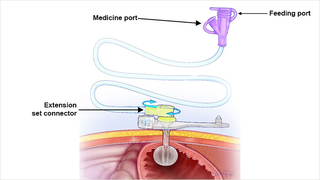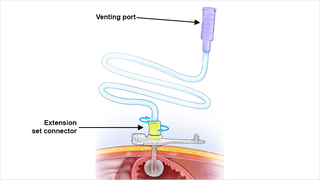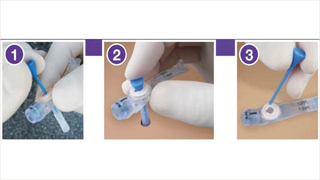Patient Instructions: Low-Profile Balloon Gastrostomy Tube
These instructions are for Children’s Hospital of Philadelphia (CHOP) patients with a new or existing low-profile G tube (gastrostomy tube). They may also be called MiniOne® or MIC-Key® button G tubes.
Important Information:
- Low-profile, balloon G tubes (gastrostomy tube), also called button G tubes, are placed directly into the stomach to give feedings, medicines, or release air. Low profile means the tube lies flat on the belly. Your child needs to be specially measured for this type of tube.

- The button G tube has a tube that passes through an opening on the skin, also called a stoma, and into the stomach. A balloon filled with water holds the tube in the stomach and prevents leaking. Do NOT use the balloon port for feedings or medicines. The inside of the feeding port has a one-way valve that works like a trap door. When the valve is closed, fluid and air from the stomach cannot flow out. To give feedings, medicine or to let air out of the stomach, a special tube called an extension set is connected. This extension set locks into the port.


Instructions for attaching the extension set:
- Hold the G tube button between your thumb and index finger. Match up the black line on the extension set with the black line on the low-profile tube.
- Push the extension set connector into the feeding port, and, while keeping pressure on the tube, turn it 3/4 of a turn in the direction of the arrow until you can turn no further. This will lock the extension into place and open the valve.
- If the connector does not turn easily, make sure that it is pushed in fully and that there is nothing blocking the opening to the feeding port.
- If the tube is turned more than 3/4 of a turn, the valve may break.
- When a feeding is finished, flush the tube, remove the extension tubing, and close the cap. Removing the extension set can prevent your child from pulling on the tube.
Instructions for cleaning the extension set:
- Wash the extension set in warm, soapy water after each use.
- Rinse well and hang to dry.
- Ask your homecare company how many sets you will receive each month. This will let you know how often you can change the extension set.
Instructions for care of the tube:
Your child’s tube should not interfere with their normal activities. Your child can play and sleep as usual. This type of tube works especially well for the active child because the tube sits flat on the belly and is easily hidden under clothing.
When the tube is placed, a tract is created from the stoma into the stomach. It takes several weeks for the tract to form and heal. When the tube is first placed in surgery, it is held in place by stitches that dissolve after 6 weeks and a water-filled balloon.
Instructions for skin care:
Post-op care:
- If a dressing is placed in the operating room, it will be changed after 48 hours or before discharge. You will change the dressing at home every day for at least the first two weeks. You should also change it if the dressing gets damp, loose, or dirty. You may use a skin barrier, such as Cavilon™ No Sting Barrier Film (if your child is over 1 month of age) to protect your child’s skin from the tape. Your healthcare provider will tell you when the dressing is no longer needed.
- For the first two days after surgery, your child can have sponge baths. The G tube can get wet in the shower but should not go under water in the tub or in a swimming pool for 4 weeks.
Daily Care:
- Wash around the stoma site and surrounding skin with mild soap and water daily, or more often if needed. You can use Q-tips® to cleanse the skin underneath and around the G tube. Be gentle. Scrubbing can slow down healing or cause skin breakdown. Rinse with water and dry well. It is normal to have a little yellow-brown drainage and redness at the opening.
- It is normal for this tube to turn on its own. If the tube is not turning and the skin underneath is getting red, you may turn it. If you are unable to turn the tube, call your healthcare provider.
Call your child’s healthcare provider if you see:
- Rash with red dots on the edges
- Signs of infection: increased redness, swelling, yellow-green drainage with a bad smell at the stoma, pain
- Open areas of skin around the stoma
- Bleeding at the stoma site
- Bleeding, painful, or growing granulation tissue around the stoma
- Increased leaking (formula or stomach fluid) at the stoma site
- The tube is leaving marks in your child’s skin
Instructions for leaking:
- If there is leaking at the stoma site, check the amount of water in the balloon.
- Hold the G tube button against the belly and pull back on the balloon port with the syringe that comes in your G tube kit. Check the amount of water that you have pulled into the syringe.
- If there is less than the usual amount, add water.
- Keep your thumb on the syringe plunger while removing the syringe from the balloon port. This will keep water in the balloon as you remove the syringe instead of flowing back into the syringe.
- Balloon volumes are different based on size and type of tube. Talk to your healthcare provider about the right amount of water for your child’s tube. If the balloon contains the correct amount of water, but is still leaking, add 0.5 ml to 1 ml of water at a time to the balloon until the leaking stops. Never have more than the maximum recommended amount of water in the balloon. If you add too much water to the balloon, it may break or cause a blockage in the intestine.
- If leaking continues, call your healthcare provider.
- While you are waiting to get instructions, keep your child’s skin dry by changing any wet gauze or dressing under the tube as needed.
- Protect the skin around the stoma with a skin barrier, such as Vaseline®, A & D® ointment, diaper cream, or Cavilon No Sting Barrier Film (if your child is over 1 month of age).
Instructions for treating granulation tissue:
Granulation tissue is a type of scar tissue that forms when the body is trying to heal itself. Because the feeding tube stoma is a new opening, your child’s body naturally may try to close it by growing this tissue. Some children have granulation tissue that grows very quickly, while others have no problem with it at all. Granulation tissue is dark pink or red, sometimes it can cause leakage and skin irritation. It may also bleed or cause pain. If this happens contact your healthcare provider.
- If you see some tissue starting to grow, discuss it with your healthcare provider at your next visit.
- If the granulation tissue around the tube is bleeding, painful, or growing rapidly, call your healthcare provider for an appointment. They may prescribe a steroid cream/ointment that you can use at home, or they may treat it in the office with a medicine called silver nitrate. These medicines shrink the granulation tissue. Granulation tissue may return and may need to be treated again.
Instructions for venting the G tube:
Venting is a way to use the tube to burp your child and let gas out of their stomach. Your child may need to be vented if their belly is bloated, if they have belly pain, or if they gag, retch, or vomit.
If your child’s tube needs to be vented, follow these steps:
- Lock straight extension set into the G tube feeding port.
- Remove the plunger from a catheter tip syringe.
- Attach syringe barrel with the plunger removed to the extension set.
- Hold syringe barrel above the level of your child’s stomach.
- Keep the tube vented for 5-10 minutes before and after feedings or as instructed.

Instructions if the tube becomes clogged:
- Try to prevent the tube from clogging by flushing the tube with water as directed after each feeding and before and after each medicine. If your child is on continuous feedings, the tube needs to be flushed at least once a day. Even a tube that is not being used must be flushed once a day.
- If the tube becomes clogged, attach a 5 ml oral syringe with warm water to the end of your feeding tube. Try to flush the tube. If you are unable to flush, pull back on the plunger of the syringe. Repeat this push and pull action up to 5 times. If you still cannot flush the tube, try using warm water in a 3 ml or 1 ml oral syringe and repeat the above steps.
- If this does not work, call your healthcare provider.
Instructions if a new G tube comes out:
No matter how long your child has had a G tube, the stoma can close very quickly.
- If you are less than 45 minutes away from one of CHOP’s hospitals, go to the nearest CHOP Emergency Department in Philadelphia or King of Prussia.
- If you are more than 45 minutes away from CHOP, go to the closest Emergency Department.
- If you go to another Emergency Department, ask them to call General Surgery at CHOP.
Instructions if the G tube comes out and you have been taught how to change it:
Change the tube by following these instructions:
- Check the balloon of the G tube to be inserted by filling the balloon with water using a syringe. Check the balloon and balloon port for any leaks. The balloon should fill evenly and completely around the tube. If the balloon leaks or does not fully fill, get another tube.
- After making sure there are no leaks in the replacement tube, reconnect the syringe and remove the water from the balloon by pulling back on the plunger. Disconnect the syringe.
- Put water-soluble lubricant on the end of the tube. Never use Vaseline® or oils. These weaken the balloon.
- Insert the end of the tube into the stoma until the tube is flat against the skin. Do not force. Each tube comes with an introducer, also called a stylet. The introducer fits inside the feeding port of the tube and makes the tube stiff. If you cannot insert the tube, you may use the introducer. When you throw out a tube, throw out its introducer as well. The next tube you use will have its own introducer. If you use the wrong introducer, you could tear the tube.
- Attach a water-filled syringe to the balloon port. Fill the balloon with water to the recommended volume.
- Check to see if the tube is in the stomach by attaching an extension set to the feeding port. Look for stomach contents in the tubing or attach a syringe to the extension set and pull back on the plunger to check for stomach contents.
- Flush the tube with water.
- Remove the extension set.
- Close the cap.

If the tube breaks and you do not have a replacement, follow these steps:
- Put water-soluble lubricant on the end of the old tube.
- Insert the end of the old tube into the stoma until the tube is flat with the skin.
- If you cannot insert the tube, you may use the introducer. Do not force the tube.
- Tape the tube to the belly to hold it in place.
- Do not feed your child through the broken tube.
- Call your home care company for a new tube or call your healthcare team for next steps.
Call your CHOP team with any questions or concerns.
If you have any questions about your child’s health, please contact your child’s healthcare provider. This document is intended only to provide general educational information and is not intended as medical advice or treatment. Please consult with your healthcare provider prior to use, as some of this information may need to be adapted for your child’s specific needs. It is the responsibility of your healthcare provider to advise you on the appropriate use of this information. If you/your child are not already a CHOP patient, this document does not create a doctor-patient relationship between you/your child and CHOP. CHOP is not responsible for any outcomes you/your child might experience from your use of this document. This document is provided "AS IS", WITHOUT WARRANTIES OR CONDITIONS OF ANY KIND, express or implied. If this document refers to any drugs or medical devices, it is the responsibility of your healthcare provider to check the FDA status prior to use. If this document includes references to drug dosing, please do not rely on this document. Your healthcare provider should check the package insert for each drug before use. Hyperlinks used within this document may not be translated into other languages.
©2022 Children’s Hospital of Philadelphia. Not to be copied or distributed without permission.